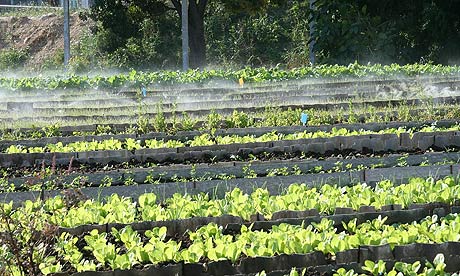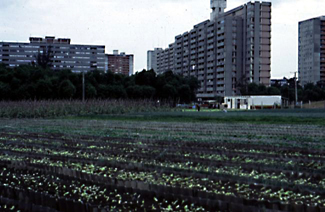| Latest | Greatest | Lobby | Journals | Search | Options | Help | Login |
|
|
|
This topic is archived. |
| Home » Discuss » Editorials & Other Articles |
|
| Demeter
|
Mon Aug-11-08 04:56 AM Original message |
| Edible Cities: Havana |
|
http://sloweb.slowfood.com/sloweb/eng/dettaglio.lasso?cod=3E6E345B13a7c25231Gnk32BE1B2
For many Cubans, the global food crisis arrived two-decades ago. Facing an economic emergency, programs were initiated to increase production of fresh food throughout cities, and today their great success is being seen as possible model for populations facing hardship around the world. During the 1990s, the Cuban government began transforming the agricultural system by giving empty city lots to workers willing to farm them and by encouraging organic methods then a response to the shortage of chemical fertilizers and pesticides. City farming took off and today 300,000 people - of which 40,000 are retirees - are employed in urban and peri-urban agriculture. Cuba's National Urban Agriculture Program has the backing of six government ministries and around 20 other institutions, social organizations and scientific research centers, which coordinate the work of thousands of intensive gardens, suburban farms, micro household gardens and other innovative forms of production. According to an Oxfam report: Today half of the fresh produce consumed by two million Havana residents is grown by nontraditional urban producers in abandoned lots and green spaces wedged into the crowded typography of the city. Its a really interesting model looking at whats possible in a nation thats 80 percent urban, said Catherine Murphy, a California sociologist who spent a decade studying farms in Havana. It shows that cities can produce huge amounts of their own food, and you get all kinds of social and ecological benefits. Among these benefits, 5,000 garbage dumps have been turned into productive vegetable gardens across Havana, and day-care centers, senior citizen homes and semi-boarding schools for primary school students, and other social centers are linked to these production areas and receive 25 percent price discounts. With fuel prices and food shortages causing unrest and hunger across the world, many say the Cuban model should proliferate. There are certain issues where we think Cuba has a lot to teach the world. Urban agriculture is one of them, said Beat Schmid, coordinator of Cuba programs for the charity Oxfam International. While many countries have experimented with urban farming - Cubas initial steps were modeled after a green belt surrounding Shanghai - nowhere has it been used so widely to transform the way a country feeds itself. WOULDN'T AGRIBUSINESSES JUST HAVE A COW OVER THIS? MY CITY JUST PASSED AN ORDINANCE PERMITTING 4 HENS PER HOUSE FOR EGG PRODUCTION! IT COULD HAPPEN HERE! http://www.columbiatribune.com/2008/Jul/20080710Busi011.asp |
| Printer Friendly | Permalink | | Top |
| Judi Lynn
|
Mon Aug-11-08 07:09 AM Response to Original message |
| 1. We've been hearing about these great leaps forward for several years. Here are some photos: |
 Organoponico plaza, Havana, Cuba. Photograph: James Pagram Cuba's organic revolutionThe collapse of the Soviet Union forced Cuba to become self-reliant in its agricultural production. The country's innovative solution was urban organic farming, the creation of 'organoponicos'. But will it survive a change of government? Ed Ewing reports guardian.co.uk, Friday April 04 2008 01:02 BST \ when the USSR collapsed in 1990/91, Cuba's ability to feed itself collapsed with it. "Within a year the country had lost 80% of its trade," explains the Cuba Organic Support Group (COSG). Over 1.3m tonnes of chemical fertilisers a year were lost. Fuel for transporting produce from the fields to the towns dried up. People started to go hungry. The UN Food and Agriculture Organisation (UNFAO) estimated that calorie intake plunged from 2,600 a head in the late 1980s to between 1,000 and 1,500 by 1993. Radical action was needed, and quickly. "Cuba had to produce twice as much food, with less than half the chemical inputs," according to the COSG. Land was switched from export crops to food production, and tractors were switched for oxen. People were encouraged to move from the city to the land and organic farming methods were introduced. "Integrated pest management, crop rotation, composting and soil conservation were implemented," says the COSG. The country had to become expert in techniques like worm composting and biopesticides. "Worms and worm farm technology is now a Cuban export," says Dr Stephen Wilkinson, assistant director of the International Institute for the Study of Cuba. Thus, the unique system of organoponicos, or urban organic farming, was started. "Organoponicos are really gardens," explains Wilkinson, "they use organic methods and meet local needs." "Almost overnight," says the COSG, the ministry of agriculture established an urban gardening culture. By 1995 Havana had 25,000 huertos allotments, farmed by families or small groups and dozens of larger-scale organoponicos, or market gardens. The immediate crisis of hunger was over. Now, gardens for food take up 3.4% of urban land countrywide, and 8% of land in Havana. Cuba produced 3.2m tonnes of organic food in urban farms in 2002 and, UNFAO says, food intake is back at 2,600 calories a day. Organoponico plaza A visit to Havana's largest organoponico, the three-hectare Organoponico Plaza, which lies a stone's throw from the city's Plaza de la Revolución and the desk of Raul Castro, confirms that the scheme is doing well. Rows of strikingly neat irrigated raised beds are home to seasonal crops of lettuces, spring onions, chives, garlic and parsley. More: http://www.guardian.co.uk/environment/2008/apr/04/organics.food?gusrc=rss&feed=environment  Cuban OrganoponicoMore: http://www.organoponico.com/?page_id=28  Havana  Revisted: Cuba's Urban Vegetable Farms ~snip~ He gestured to the rows of vegetables--beets, spinach, chives, planted in neat beds. As we made our way through the herb garden, he then started explaining the benefits of the herbs to me: siempre viva is for headaches, chamomile helps with skin problems, anise is to give you a strong stomach. Or, as Nestor put it, "Le da animo." It gives you spirit. We stopped under the shade of fruit trees, where he showed me a passionfruit, still green on the tree, and then a noni fruit, pale yellow and naturally pocked. He picked a few small ripe bananas for me to try. "If this wasn't a garden, it would be filled with garbage. Instead, all year long we have food for the people," Nestor said, then added the distinctly Cuban phrase, "Tiene que resolver." "Resolver" has been Cuban's battle cry, chant, groan since the Special Period. It means to find a way to survive, to make the impossible, possible. When the Soviet Union collapsed in 1989, Cuba lost 80 percent of its imports. Known as the "The Special Period," government food rations were cut in half, public buses didn't run, and blackouts rolled through the cities. Hoping to crush the government, the United States tightened the embargo by passing the Cuban Democracy Act (1992) that prevents the docking at a U.S. port of any ship that has docked in Cuba six months prior or that plans to visit Cuba within six months after. This further reduced food and medicine reaching the island.More: http://www.citydirt.net/2008/05/  Organic Farming Feeds A NationMore: http://www.wafreepress.org/46/organic_farming.html They have been teaching this method to Venezuelans!    Workshops The garden - named after Mr Chavez's hero Simon Bolivar, the 19-Century independence fighter - holds workshops for university students and organises visits for schoolchildren. "They can then replicate what they've learnt in their homes," Juan says. "Even if they do not have a garden, they can plant vegetables in boxes and put them on window sills or rooftops."  Successful stall The harvested crops are sold from a stall by the garden. The prices are lower than in the supermarkets. Four organic lettuces, for example, cost less than half a dollar. The stall opens at 0830 each morning - by lunchtime, most of the vegetables, fruits, herbs and flowers have been sold. Text: Nathalie Malinarich. Photos: Emma Lynch. Small photo journal: http://news.bbc.co.uk/2/shared/spl/hi/picture_gallery/07/americas_harvest_in_caracas/html/1.stm    http://www.cityfarmer.info/caracas-venezuela-embraces-city-gardening-for-improved-nutrition-jobs/ |
| Printer Friendly | Permalink | | Top |
| DU
AdBot (1000+ posts) |
Fri May 03rd 2024, 09:50 PM Response to Original message |
| Advertisements [?] |
| Top |
| Home » Discuss » Editorials & Other Articles |
|
Powered by DCForum+ Version 1.1 Copyright 1997-2002 DCScripts.com
Software has been extensively modified by the DU administrators
Important Notices: By participating on this discussion board, visitors agree to abide by the rules outlined on our Rules page. Messages posted on the Democratic Underground Discussion Forums are the opinions of the individuals who post them, and do not necessarily represent the opinions of Democratic Underground, LLC.
Home | Discussion Forums | Journals | Store | Donate
About DU | Contact Us | Privacy Policy
Got a message for Democratic Underground? Click here to send us a message.
© 2001 - 2011 Democratic Underground, LLC